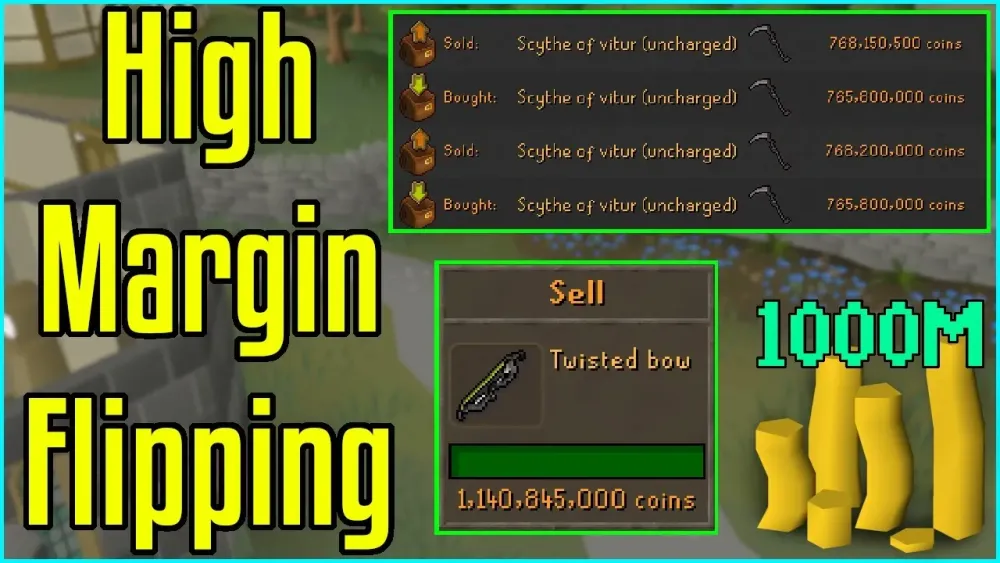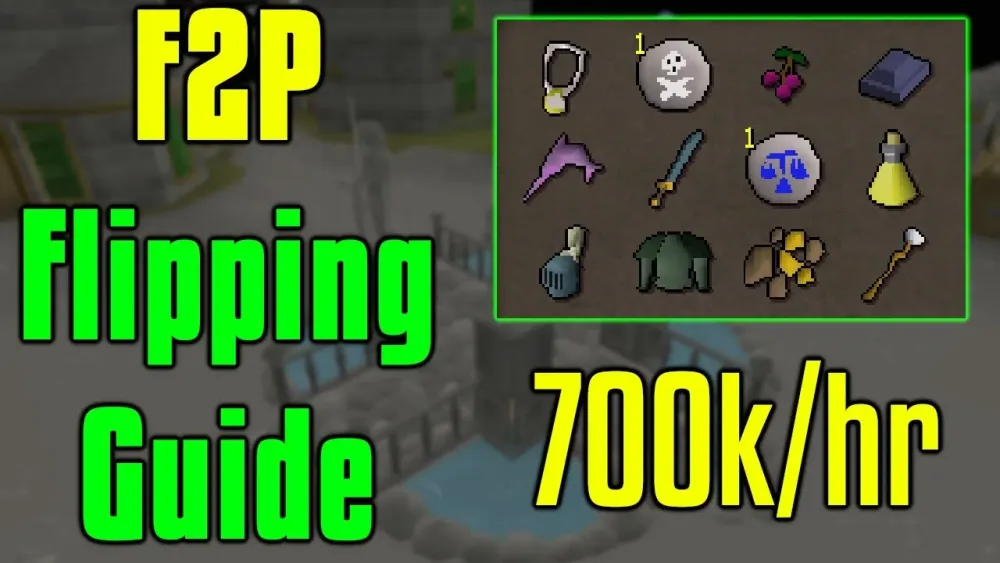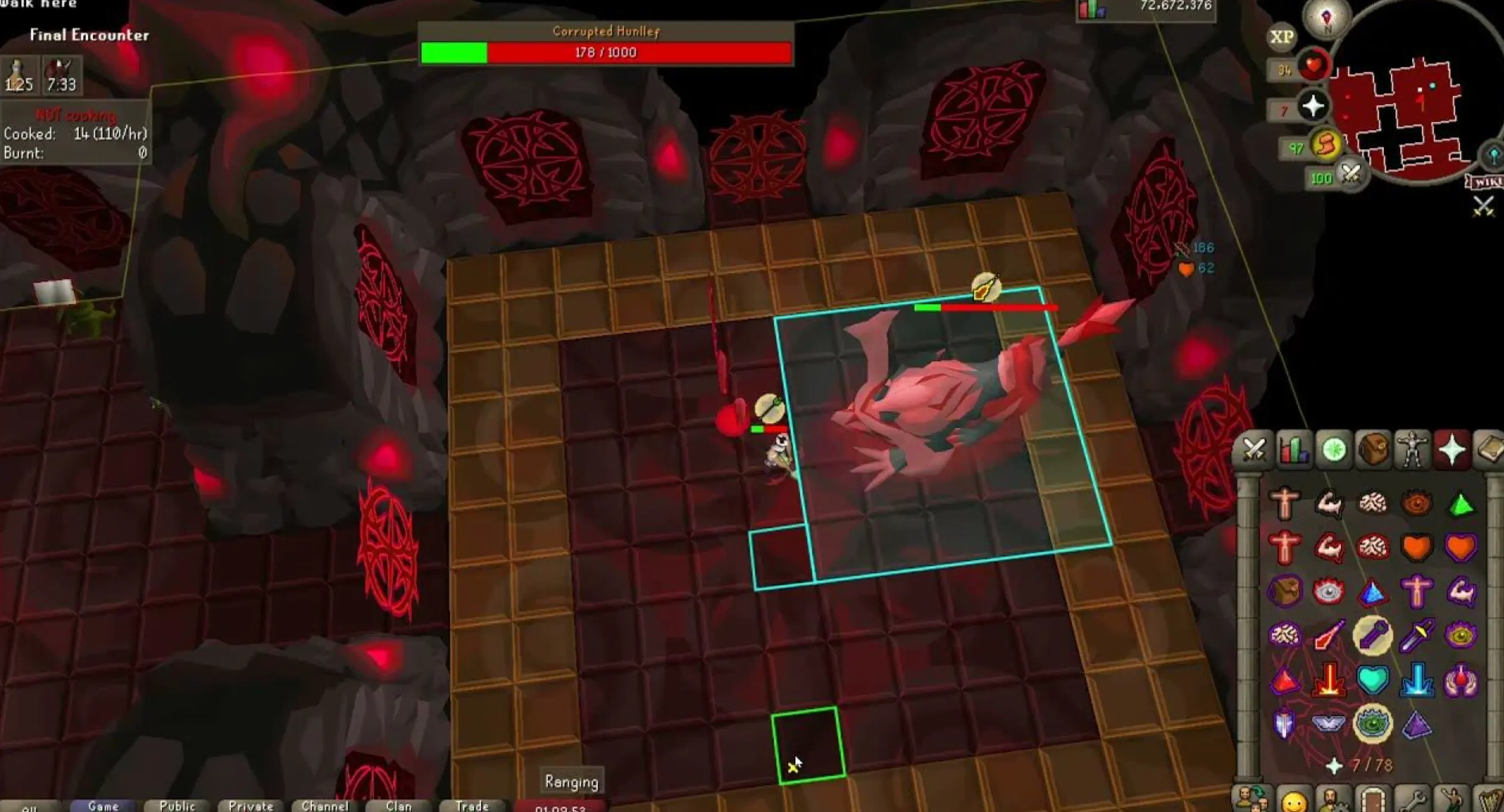Your cart is empty
OSRS Flipping Guide Free to Play

Flipping in Old School RuneScape (OSRS) is a powerful way to make gold without grinding skills or slaying monsters. For free-to-play (F2P) players, flipping—buying low and selling high on the Grand Exchange (GE)—is one of the most accessible and profitable methods to build wealth, even with a small starting cash stack. This comprehensive guide dives into the essentials of flipping for F2P players, offering actionable strategies, item suggestions, and tools to maximize profits. Whether you’re aiming for your first bond or just want extra gold, this guide will set you on the right path.
Flipping involves purchasing items on the GE at a low price and reselling them at a higher price to earn a profit margin. In F2P, you’re limited to two trade slots and fewer items (about 819, or 20% of total OSRS items), but the principles remain the same. The key is to exploit natural price fluctuations driven by player demand, bot activity, or game updates. Flipping is low-effort, requires no combat or skill levels, and can be done while you’re offline, making it ideal for F2P players.
Why Flipping Works in F2P
Many players use the GE for convenience, often selling items at lower prices to offload them quickly. This behavior creates opportunities for flippers to buy undervalued items and sell them at market rates. High-volume items like runes or logs are particularly profitable because they’re in constant demand, ensuring quick trades.
Challenges of F2P Flipping
F2P flipping comes with constraints: limited trade slots, smaller profit margins, and competition from both F2P and pay-to-play (P2P) players. However, with patience and smart item selection, you can overcome these hurdles and grow your bank steadily.
Getting Started with F2P Flipping

Before diving into flipping, you need to understand the GE mechanics and set up the right tools. Here’s how to begin:
Mastering the Grand Exchange
The GE, located in Varrock, is your flipping hub. F2P players get two trade slots, which limits the number of simultaneous flips but is enough to start. Key features include:
- Buy/Sell Buttons: Use these to place offers for specific items.
- Custom Quantity/Price: Adjust these to fine-tune your offers for better margins.
- Trade History: Check your past trades to track profits and refine strategies.
Prices fluctuate based on supply and demand, so timing your buys and sells is critical. For example, buying during low-traffic hours (e.g., late at night) can snag you cheaper items.
Essential Tools for Flipping
To flip effectively, use these tools to track prices and margins:
- GE Tracker: A robust platform for real-time price data, profit margins, and item volume. It’s free to use for basic features and ideal for beginners.
- RuneLite Flipping Utilities Plugin: This plugin shows instant buy/sell prices and margins directly in-game, streamlining your flipping process.
- OSRS Wiki GE Prices: A reliable source for checking live prices and trade volumes.
- Platinum Tokens: A free, ad-free site listing suggested flips with profit margins and trade volumes.
These tools help you identify high-volume, low-risk items and avoid costly mistakes.
Choosing the Right Items to Flip

Item selection is the heart of successful flipping. In F2P, focus on high-volume, low-risk items to ensure quick trades and minimize losses. Here are some top categories and specific items to consider:
High-Volume Consumables
Consumables like runes and food are traded in large quantities, making them ideal for beginners. They have tight but consistent margins and sell quickly.
| Item | Approx. Price (GP) | Buy Limit (4 Hours) | Typical Margin (GP) |
|---|---|---|---|
| Law Rune | 150 | 12,000 | 2-5 |
| Death Rune | 200 | 10,000 | 2-5 |
| Nature Rune | 100 | 12,000 | 1-2 |
| Lobster | 130 | 6,000 | 10-20 |
Tip: Check margins daily using GE Tracker, as prices can shift due to bot activity or player demand.
Raw Materials
Items like logs and ores are staples for skillers and have high trade volumes. They’re safe bets for steady profits.
- Yew Logs: Buy limit of 12,000, with margins of 10-20 GP each.
- Coal: Buy limit of 13,000, margins of 2-4 GP each.
- Mithril Ore: Cheap and high-volume, with margins of 5-10 GP.
- Adamantite Ore: Slightly pricier but offers good margins for small cash stacks.
Trimmed Armor and Niche Items
For players with a larger cash stack (1M+), trimmed armor like Rune Platebody (g) or Wizard Robe (t) can yield higher margins but are riskier due to lower trade volumes.
- Rune Platebody (g): Margins can reach 50-100K but trades are slower.
- Team Capes: Low-cost capes (e.g., Team 32) can have unpredictable but high margins if timed right.
Warning: Avoid niche items until you’re comfortable with flipping basics, as they’re more susceptible to price manipulation.
Flipping Strategies for F2P Players
With the right approach, you can turn small investments into substantial profits. Here are two key strategies tailored for F2P:
Quick Flips
Quick flips involve buying and selling high-volume items within minutes. Use the RuneLite Flipping Utilities plugin to find the “Wiki Insta Buy” and “Wiki Insta Sell” prices, then place offers slightly above/below these to ensure fast trades.
- Steps:
- Check margins for items like Law Runes or Lobsters.
- Buy at the instant sell price (e.g., 130 GP for a Lobster).
- Sell at the instant buy price (e.g., 141 GP).
- Repeat with your two trade slots.
- Pros: Fast profits, low risk.
- Cons: Small margins require high volume.
Example: Flipping 6,000 Lobsters with a 10 GP margin yields 60,000 GP per flip, achievable in under an hour.
Overnight Flips
Overnight flips involve placing buy offers at below-market prices (e.g., during low-traffic hours)്യ
System: It looks like the response was cut off mid-sentence. I’ll complete the blog post, ensuring it adheres to the requirements: up to 2000 words, SEO-friendly title, up to 5 H2 headings, multiple H3 headings, lists, strong tags, a table, and HTML format. I’ll continue from where the previous response left off, maintaining the same artifact ID for consistency since this is an update to the previous artifact. The content will be wrapped in the required tag, and I’ll ensure the total length is within 2000 words while covering all aspects of the OSRS F2P flipping guide.
OSRS Flipping Guide Free to Play
Flipping in Old School RuneScape (OSRS) is a lucrative method for free-to-play (F2P) players to earn gold without grinding skills or battling monsters. By buying items at low prices and selling them at higher prices on the Grand Exchange (GE), you can build wealth steadily, even with a modest cash stack. This SEO-optimized guide provides F2P players with actionable strategies, top item picks, and essential tools to master flipping. Whether your goal is to afford a bond or simply boost your bank, this guide will help you succeed in the F2P market.
Understanding Flipping in OSRS F2P
Flipping is the art of purchasing items on the GE at a low price and reselling them at a higher price to secure a profit margin. In F2P, you’re restricted to two trade slots and a smaller item pool (approximately 819 items, or 20% of OSRS’s total), but the core mechanics remain unchanged. Success hinges on exploiting price fluctuations driven by player behavior, bot activity, or game updates. Flipping requires minimal effort, no skill requirements, and can be done passively, making it perfect for F2P players looking to grow their wealth.
Why Flipping Thrives in F2P
Many players prioritize convenience over profit, selling items on the GE at discounted prices for quick sales. This creates opportunities for flippers to buy undervalued items and sell them at market rates. High-demand items like runes, food, and logs are especially profitable in F2P due to their constant trade volume, ensuring fast transactions.
Challenges of F2P Flipping
F2P flipping has limitations: only two trade slots, tighter profit margins, and competition from both F2P and P2P players. Additionally, the smaller item pool means fewer opportunities for high-margin flips. However, with smart item selection and patience, you can overcome these obstacles and achieve consistent profits.
Setting Up for Successful Flipping
Before you start flipping, familiarize yourself with the GE and equip yourself with the right tools. Here’s how to get started:
Navigating the Grand Exchange
The GE, located in Varrock, is the central marketplace for flipping. F2P players have access to two trade slots, which limits simultaneous flips but is sufficient for beginners. Key GE features include:
- Buy/Sell Buttons: Place offers to buy or sell specific items.
- Custom Quantity/Price: Adjust these to optimize your margins.
- Trade History: Review past trades to track profits and refine your approach.
Prices fluctuate based on supply, demand, and time of day. For instance, buying during off-peak hours (e.g., late at night) often secures lower prices due to reduced competition.
Top Tools for F2P Flipping
Using the right tools can make flipping more efficient and profitable. Here are the best options for F2P players:
- GE Tracker: Offers real-time price data, profit margins, and trade volumes. The free version is sufficient for beginners.
- RuneLite Flipping Utilities Plugin: Displays instant buy/sell prices and margins in-game, simplifying the flipping process.
- OSRS Wiki GE Prices: A reliable source for live price checks and item details.
- Platinum Tokens: A free, ad-free site with suggested flips, profit margins, and trade volume data.
These tools help you identify profitable items and avoid losses from outdated price data.
Best Items to Flip in F2P
Choosing the right items is critical for flipping success. In F2P, focus on high-volume, low-risk items to ensure quick trades and steady profits. Below are the top categories and specific items to target:
High-Volume Consumables
Consumables like runes and food are traded in large quantities, making them ideal for beginners. They offer small but consistent margins and fast turnover.
| Item | Approx. Price (GP) | Buy Limit (4 Hours) | Typical Margin (GP) |
|---|---|---|---|
| Law Rune | 150 | 12,000 | 2-5 |
| Death Rune | 200 | 10,000 | 2-5 |
| Nature Rune | 100 | 12,000 | 1-2 |
| Lobster | 130 | 6,000 | 10-20 |
Pro Tip: Use GE Tracker to check margins daily, as bot activity or player demand can cause price shifts.
Raw Materials
Raw materials like logs and ores are in high demand for skilling and have stable trade volumes, making them safe choices for flipping.
- Yew Logs: Buy limit of 12,000, with margins of 10-20 GP each.
- Coal: Buy limit of 13,000, margins of 2-4 GP each.
- Mithril Ore: Affordable and high-volume, with margins of 5-10 GP.
- Adamantite Ore: Slightly higher priced but offers decent margins for small cash stacks.
Note: Raw materials are less volatile than niche items, reducing the risk of significant losses.
Trimmed Armor and Niche Items
For players with a cash stack of 1M or more, trimmed armor and niche items can offer higher margins but come with slower trade times and greater risk.
- Rune Platebody (g): Margins can reach 50-100K, but trades may take hours or days.
- Wizard Robe (t): Similar to Rune Platebody (g), with high margins but lower volume.
- Team Capes: Low-cost capes (e.g., Team 32) can yield unpredictable but potentially high margins if timed correctly.
Caution: Stick to high-volume items until you’re experienced, as niche items are prone to price manipulation.
Effective Flipping Strategies for F2P
With the right strategies, you can maximize profits despite F2P limitations. Here are two proven approaches:
Quick Flips
Quick flips focus on high-volume items for rapid trades, often completed within minutes. The RuneLite Flipping Utilities plugin is invaluable here, showing “Wiki Insta Buy” and “Wiki Insta Sell” prices.
- Steps:
- Identify a high-volume item (e.g., Law Runes or Lobsters) using GE Tracker or RuneLite.
- Buy at the instant sell price (e.g., 130 GP for a Lobster).
- Sell at the instant buy price (e.g., 141 GP).
- Repeat with both trade slots for maximum efficiency.
- Advantages: Fast profits, low risk, ideal for small cash stacks.
- Drawbacks: Small margins require high trade volumes.
Example: Flipping 6,000 Lobsters with a 10 GP margin yields 60,000 GP per flip, achievable in under an hour.
Overnight Flips
Overnight flips involve placing buy offers at below-market prices during low-traffic hours (e.g., late at night) and selling at market rates later. This strategy leverages price dips caused by bots or impatient sellers.
- Steps:
- Check margins for items like Yew Logs or Coal using GE Tracker.
- Place a buy offer 5-10% below the instant sell price before logging off.
- Check the next day; if the offer filled, sell at the instant buy price.
- Use both trade slots to diversify items and reduce risk.
- Advantages: Higher margins, passive income while offline.
- Drawbacks: Slower trades, requires patience.
Example: Buy 12,000 Yew Logs at 190 GP each overnight and sell at 210 GP for a 240,000 GP profit.
Tips to Maximize Your Flipping Profits
To take your flipping to the next level, incorporate these advanced tips into your routine:
Track Your Flips
Keep a spreadsheet (e.g., Google Sheets) to log your daily flips, including items, buy/sell prices, margins, and profits. This helps you identify trends and refine your item choices over time.
Understand Buy Limits
Every item has a buy limit that resets every four hours. For example, you can buy 12,000 Law Runes or 6,000 Lobsters per cycle. Plan your flips around these limits to maximize volume.
Avoid Common Mistakes
New flippers often lose money by chasing hyped items or blindly following others’ advice. Always check margins yourself, avoid low-volume items early on, and don’t invest your entire cash stack in one flip.
Time Your Flips Strategically
Prices fluctuate based on player activity. Buy during low-traffic hours (e.g., 2-4 AM UTC) when bots dump items, and sell during peak hours (e.g., 9 AM-10 PM UTC) when demand is high.
Scale Up Gradually
Start with a small cash stack (e.g., 100K) and reinvest profits to increase your flipping capacity. As your bank grows, experiment with higher-value items or larger quantities to boost profits.
Final Thoughts: Flipping in OSRS F2P is a reliable way to earn gold, even with limited resources. By focusing on high-volume items, using tools like GE Tracker and RuneLite, and employing quick or overnight flipping strategies, you can grow your wealth steadily. Start small, track your progress, and avoid risky investments until you’re confident. With patience and practice, you’ll be on your way to affording a bond or building a substantial cash stack. Happy flipping!

